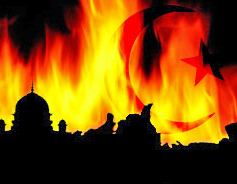Muhammadan Traditions & Fetishes:-
The shrines, symbols and rituals of 'modern Islam' were practiced by Arab polytheists long before Muhammad was born. Muhammadan Islam is Repackaged and 'Islamized' Polytheism; unlike the religion of the Jews (Mosaic Faith) or Christianity, it is repackaged Arabian Paganism or "Polytheism wrapped in a Monotheistic veil".
The following are similarities between the new Cult of Muhammad and what was already practiced by the Pagan Arabs for centuries before him:
A The Ka'ba was the holiest site in pagan Arabia (and continues to be so for the followers of Muhammad).
B Mecca was the centre of pagan Pilgrimage/Hajj as it is today.
C In Mecca, the pagan Quraysh - before Muhammad - already had a supreme god/creator called Allah (a generic composite name of Al Ilah).
In fact, of all the 360 gods and goddesses in the Ka'ba, only Allah had no stone/statue; this is confirmed by the fact that the Quraysh, the tribe of Muhammad, never accused him of preaching another Allah than theirs.
The Jahilyia Arabs - as well as the Jews of Arabia - used to invoke his name regularly just as Muhammadans do so today. The only difference brought about by Muhammad was that he allowed only the god Allah to remain and destroyed all the others.
The Quran itself testifies that Allah is the name of the Almighty among the Arabs, the People of the Book and others long before Muhammad.
D Ramadhan was one of four holiest months in the calendar of the pagan Arabs; Muhammad continued the pagan practice and made it the most important one for his followers.
E The Pilgrimage/Hajj to Mecca was part and parcel of the pagan traditions that Muhammad continued.
F The Black Stone was holy to the pagans and continued to be thereafter by Muhammad and his followers.
G Venerating the Balck Stone by kissing it was continued by Muhammad as it was under the pagans.
H The circumambulation (Tawaf) of the Ka'ba was a pagan tradition and is continued by the Muhammadans.
I The wearing of the Ihram (white clothing) was pagan and is also continued.
J The Saii (running seven times between the two hills of Safa and Marwa) was pagan and was continued but redefined by Muhammad to suit his new Cult Belief System.
K Muhammad carried forward many parts of the Sharia rules from the pagan Arabs such as:
Marrying mother and daughter was prohibited; marrying two sisters simulataneously was forbidden; marrying a stepmother was unacceptable.
Many of these were of course already prohibited in the Bible whose influence among the Peninsula Arabs, after almost 1000 years of intermingling, was very important.
L Many acts performed by Muhammad were in common usage among the pagans but were made 'mandatory' through the 'Sunna al Nabawyia' ie the way Muhammad conducted his daily life, such as:
gargling, clipping their finger nails, shaving their pubic hair, sniffing water up their nostrils, washing after intercourse, etc.
{(Al-Milal wa al-Nihil, Muhammad ibn 'Abdalkarim al-Sharastani, Muslim, vol. 2 chapter on the opinions of the pre-Islamic Arabs, as quoted in al-Fadi}
M Zamzam was holy to the pagans and continued under Muhammad.
N Many of the pagans prayed 5 times towards their holy shrines. The Sabeans prayed five times facing Mecca.
Muhammad at first directed his prayers and those of his followers towards 'Jerusalem' but later changed it towards Mecca - also 5 times a day - in spite after the Jews refused to follow and convert to his new 'religion'.
O Circumcision was practiced by some of the pagans but the Quran does not make it mandatory.
P The throwing of stones at the 'devil/jinn' was also a pagan tradition that was continued by Muhammad (at Mina) with the usual relevant redefinitions of the practice to suit his new Cult Belief System.
R The four holy months of pagan Arabia were retained as such by Muhammad and his followers.
S Fasting and abstaining from sexual intercourse at certain times were also
pagan practices that were retained by Muhammad with some appropriate modifications and explanations to suit his agenda.
T The pagan symbols for the crescent moon and the star of Venus are also used by the Muhammdans on their mosques, emblems and flags and are a reflection of the idols of the Quraysh.
Almost the entirety of pagan traditions, fetishes and symbols are carried forward in the 'new religion' of Muhammad.
The clear conclusion is that Muhammad did not bring about a new religion but only a reformation of the established one among the pagan Arabs. That is why there is actually nothing new and/or revolutionary in his theology?
On top of what he carried forward from the pagans - whom he vehemently despised, denigrated, attacked and insulted - he also plagiarised, plundered, pirated and/or perverted from the Bible, the New Testament, Zoroasterian religion, pagan Arabian religion, their scriptures, their traditions and their fetisheasd to compose his version of 'Arabian scripture'; his Quran.
25: 5 "And they say: "Tales of the ancients which he has caused to be written: and they are dictated before him morning and evening."
This verse of the Quran - among dozens more - testifies that Muhammad's own Quraysh tribe did not believe in his alleged 'revelations' and KNEW with certainty, that somone else was actually 'revealing' them to him ***
